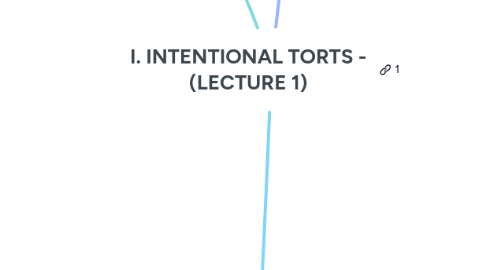
1. Harms to Person
1.1. Assault
1.1.1. Apprehension of the imment harmful or ofensive contact
1.1.1.1. Subjective standard
1.1.1.2. P MUST be aware of the assault
1.1.1.3. P must believe that D has a present ability
1.1.1.4. Words along = NOT enough
1.1.1.5. Different from negligent act
1.2. Battery
1.2.1. Harmful or offensive contact
1.2.1.1. Intent
1.2.1.2. Harmful or offensive touching
1.2.1.3. Without P's consent
1.2.1.3.1. different from negligence
1.2.1.4. Transferred intent
1.2.1.4.1. Intent --> passes to a 3rd party
1.2.1.5. Direct or indirect
1.2.1.6. Awareness of P is not required
1.2.1.7. No consent from P
1.2.1.7.1. unless incapacity to consent
1.2.1.7.2. unless duress
1.2.1.7.3. consent to illegal act -- valid
1.2.1.7.4. consent to combat
1.2.1.8. UNLESS exceeded the consent
1.2.1.9. UNLESS emergency situations
1.2.1.9.1. test: would a reasonable person as a patient would grant consent
1.2.1.9.2. lack of informed consent - failure to disclose th relevant risk in full (now -- negligen ce)
1.3. False Imprisonment
1.3.1. 1. intent
1.3.2. 2. confindment
1.3.2.1. no freedom to move
1.3.3. 3. P is aware of confindment
1.3.4. 4. there is no consent
1.3.5. If not aware = must have physical harm
1.3.6. unlawful authority
1.3.6.1. Defense: shopkeeper privilege
1.4. Intentional Infliction of Emotional Distress
1.4.1. Intent -- extreme and outrageous conduct by D
1.4.1.1. intent
1.4.1.2. recklessness
1.4.2. Severity of Emotional Distress
1.4.3. Special Relationship
1.4.3.1. common carriers; inkeepers
1.4.4. Bystander
1.4.4.1. Must be present
1.4.4.2. Close relative OR Physical harm
1.4.4.3. D must know about that
2. Harms to Property
2.1. Trespass
2.1.1. Trespass to Land
2.1.1.1. Physical entry
2.1.1.2. Intent
2.1.1.2.1. unintended intrusion = NO a trespass
2.1.1.3. P = must have a posession of right
2.1.1.3.1. even adverse posession = OK
2.1.1.4. D interferes with that right
2.1.1.4.1. Exceptions:
2.1.1.4.2. Privilege: emergency -- to protect his own person or property
2.1.1.4.3. Privilege of police power
2.1.2. Trespass to Chattel
2.1.2.1. D intentionally interferes with P’s right of possession in tangible personal property (chattel)
2.1.2.2. Minor interference or damage
2.1.2.3. Damages: cost of repair or rental value of chattel
2.2. Conversion
2.2.1. D intentionally interferes with P’s right of possession in tangible personal property (chattel)
2.2.2. Significant interference or damage that justifies D paying the chattel’s full value
2.2.3. Damages: full market value at the time of conversion or repossess the chattel (replevin)
3. Defenses
3.1. Defense to Personal Harm
3.1.1. Consent: express or implied
3.1.1.1. Express
3.1.1.1.1. verbal or written consent
3.1.1.2. Implied
3.1.1.2.1. D can reasonably infer P’s consent based on custom or P’s observable conduct
3.1.1.2.2. emergency
3.1.1.2.3. injuries in athletic contests
3.1.1.2.4. mutual consent to combat
3.1.1.3. P must be capable of consenting
3.1.1.3.1. drunks, mentally impaired, and young children are incapable of consenting to tortious conduct
3.1.1.4. Scope of consent
3.1.2. Self-defense
3.1.2.1. reasonable under the circumstances
3.1.2.2. if using deadly
3.1.2.2.1. duty to retreat if there arfe any means to excape
3.1.2.2.2. deadly force AGAINST deadly force
3.1.2.3. if injuring a 3rd party -- still privileged UNLESS negligent
3.1.3. Defense of others
3.1.3.1. D must have reasonable belief that the person he is aiding would have the right of self-defense
3.1.3.2. the defending perosn takes the risk if the perosn he is defending DOES NOT have a privilege
3.1.4. Shopkeeper Privilege
3.1.4.1. reasonable cause to believe a theft occurred
3.1.4.2. reasonable manner (only non- deadly force is permitted) for purposes of investigation
3.1.4.3. reasonable in length and scope
3.1.4.3.1. Shopkeeper may be held liable for any harm caused by acts exceeding the privilege
3.1.5. Privilege to arrest
3.1.5.1. felony
3.1.5.1.1. committed
3.1.5.1.2. attempt to commit
3.1.5.1.3. reasonable belief
3.1.5.2. misdemeanor
3.1.5.2.1. safety of others
3.1.6. Defense of property
3.1.6.1. reasonable force
3.1.6.2. NO PRIVILEGE to use force which causes death OR serious injuries
3.1.6.3. before using force -- there should be a DEMAND
3.2. Defense of Property
3.2.1. Necessity
3.2.1.1. 1) D’s interference with P’s property must be reasonably necessary to avoid an immediate threatened injury
3.2.1.2. 2) Threatened injury must be more serious than the interference undertaken to avert it
3.2.1.2.1. private - limited defense
3.2.1.2.2. public - absolute defense
3.2.1.3. IF EXPELS -- the owner will be liable for any damage caused
3.3. Immunities
3.3.1. Federal
3.3.1.1. Federal Torts Claim Act
3.3.1.2. US is NOT liable for: assailt, battery, false imprisonment, false afrrest, malicious inmterference, abuse of process, lib el, slander, miksrepresentation or tortious interference
3.3.2. State
3.3.2.1. doctrine of sovereign immunity
3.3.2.2. can sue on ly if the statute allows that
3.3.3. Municipal
3.3.3.1. govermental
3.3.3.1.1. immune
3.3.3.2. proprietary
3.3.3.2.1. not immune
3.3.4. Public Officers
3.3.4.1. depends on the level of public officer
